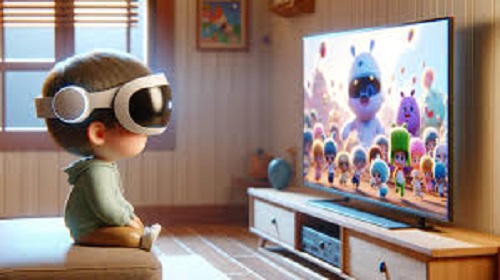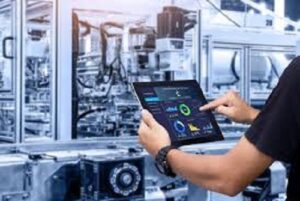The Future Of AR Animation Videos
The Future Of AR Animation Videos: Augmented Reality (AR) is one of the most promising technologies that has emotionally coloured the way anybody uses digital content in the real or physical environment. On the other hand, animation has been used for many years as a way of making a concept or story or a character come alive through movement and graphics. The integration of two media AR and animation means that users can activate animations as if they were in a science fiction film.
AR technology is gradually advancing, and it is gradually merging with animation and impacting industries such as entertainment, education, marketing, and healthcare. This blog will focus on the article “The Future of AR Animation Videos”, examining the technology behind it, the prospects and prospects, as well as drawbacks.

What is AR Animation?
AR Animation is a technique that uses augmented reality (AR) in animation by overlaying animated characters or objects. They add interactive digital content to the physical environment that can vary from a smartphone screen to AR glasses. This integration enables users to carry out activities interacting with animated objects in real-time, thereby adding value and interactivity to a bunch of fields including entertainment, education and marketing.
Significance of AR Animation Videos

AR Animation Videos have emerged as a powerful tool with far-reaching implications across multiple sectors:
- Enhanced User Engagement: By integrating animation with AR, the creators can share content that is not only graphically engaging but also provides certain interactivity. Interacting with animated characters and situations within the environment makes it interesting and easier for users to remember. This is especially so in marketing whereby one can follow with interactive ads that can be easily remembered.
- Revolutionizing Entertainment: Entertainment industries are applying the theory of AR in animation videos, hence changing the way consumers interact with content. The concept of transmitting users into the centre of the stage is evident when using AR animations: whether it is games or the scenes in a movie. From this point of view, the transformation of staying just an observer into becoming an actor enhances the fun factor and at the same time adds depth to the notion of storytelling.
- Transforming Education: Another area that is benefited from AR animation videos is education. Augmented reality can also be used by designing animated models to deliver full descriptions to the students, patients or clients about certain concepts that are hard to understand; this makes learning easier, more engaging and more effective. For instance, students can ‘explore’ some events in history or a certain process in science in 3D and get to know more things in multimedia form.
- Innovative Marketing and Advertising: AR animation videos are rapidly becoming the new tools that can shape firms’ customer relations. AR in the context of engaging commercials and delivering products to the target market establishes a unique selling proposition for the features and benefits. This way not only captures the attention of the consumers but also provides a kind of a feel of the product before getting an actual feel of it.
- Advancing Healthcare: In the healthcare segment, AR is applied for patient education and therapy. Animated AR clips describe medical operations in detail, help with exercises, and teach medical personnel, which directly leads to improved patient care and health literacy.
Key Trends Shaping AR Animation Videos
Several trends are driving the evolution of AR animation videos, highlighting their growing importance and potential:

Integrating big data with various AI and ML functions
AI and machine learning are making tremendous impacts on the features of AR animation videos. AI allows for enhanced usability between a user and an animated object or figure, for instance, smarter figures that respond to actions by a user. It also expands the domain of animations as machine learning learns and mimics human movements and actions.
Advancements in AR Hardware
AR hardware such as the next-generation AR glasses and AR headsets are emerging to support better experiences. Smart glasses like Microsoft’s HoloLens and Apple’s prospective AR glasses are built to produce a high-quality and fully immersive AR experience for the user while interacting with animations in a hassle-free manner.
Growth of 5G Technology
The use of 5G networks is expected to improve the connectivity of AR animation videos and make the service better. The lower latency and higher bandwidth of 5G make it possible to deliver more complicated and data-heavy AR animations and act out largely real-time cooperation and shared experiences.
Expansion of the Metaverse
The concept of the metaverse, a collective virtual shared space, is gaining traction. AR animation videos will play a crucial role in the metaverse by creating immersive environments where users can interact with animated content and each other. This trend highlights the potential for AR animations to enhance virtual social interactions and experiences.
Customization and Personalization
It is emerging that many interactive AR animation videos are now designed to have modifiable aspects, giving the viewers a chance to customize. This trend involves adapting features like animated avatars or the design of the environment to better match the user’s preferences and provide a higher level of satisfaction.
Technological Advancements Driving the Future
Several technological advancements are shaping The Future of AR Animation Videos:

- Artificial Intelligence (AI) and Machine Learning: AI and machine learning add to the animation by providing better realism by allowing interaction with the characters in the animation. They also enhance realism in animations by emulating human behaviours. The following are the advanced technologies related to animation.
- 5G Technology: The availability of 5G yields better coverage and reliable connection with less delay, allowing for intricate and data-driven animations. This made it possible to offer real-time interaction and more advanced multiple-user engagements.
- Advanced AR Hardware: New developments in AR hardware such as personal wearable devices like AR glasses and AR headsets enhance the interaction of the users with augmented reality hence enhancing the experience. These devices are capable of providing high-quality visuals and interactivity thus opening up more possibilities for animation in AR.
- Virtual Reality (VR): The characteristic of virtual reality technology is that it allows interaction with animated content in the environment, recreating reality. It makes the animation experience more enjoyable and realistic due to this advancement.
- Real-Time Rendering: The improved technology in real-time rendering leads to the production of more complex pictures and quick updates. This improvement helps increase the visual quality and smoothness of produced animations in interactive applications.
- Motion Capture: Advanced movements and facial expressions of human characters are recorded accurately and then used in making more realistic animated characters. It makes the characters in animations look and feel more real and have deeper emotions.
- Blockchain and NFTs: Blockchain technology and NFTs provide innovative solutions to safeguard and commercialize creators’ copyrighted content. They offer the guarantee of ownership and identity and are easily verifiable; they also can give animators new sources of income.
Challenges for Animators and Creators in The Future of AR Animation Videos
In the evolving animation industry, animators face unique challenges and opportunities that shape their success:

- Staying Competitive: As the number of creators and programs increases, it becomes challenging for animators to learn and improve as well as come up with creative ways to entertain audiences.
- Embracing New Technologies: New technologies, including VR and AR, are among the most promising opportunities but are also accompanied by threats. Learning these tools can result in revolutionary, absorbing animations.
- Adapting to Viewer Preferences: With the growing complexity of audiences, animators must learn how to meet new expectations and address emerging trends like vertical videos for mobile devices.
- Balancing Creativity and Commerce: These artists need to balance art with commerce – there are goals tied to business needs, such as target figures in advertising, which can hinder creativity but also drive people to find new ways to meet these goals.
- Managing Intellectual Property: In the digital world and with the use of tokens, especially NFTs, it becomes challenging to protect and make profits from intellectual property. Such areas include how animators have to deal with the rights of copying that exist in society as well as look for ways through which he or she can protect their work and generate income in equal measure.
- Interactive and Multiplatform Storytelling: The growth of two-way and multiscreen content presents new possibilities but makes the role of animators oversight content between platforms and interfaced design.


